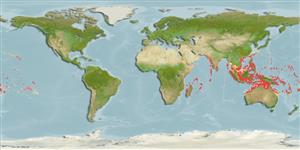分類 / Names
共通名の | 類義語 | Catalog of Fishes(部類, 種) | ITIS | CoL | WoRMS | Cloffa
>
Anguilliformes (Eels and morays) >
Muraenidae (Moray eels) > Muraeninae
Etymology: Rhinomuraena: Greek, rhinos = nose + Latin, muraena = morey eel (Ref. 45335).
More on author: Garman.
Environment: milieu / climate zone / depth range / distribution range
生態学
海 関連する礁; 移住性ではない; 深さの範囲 1 - 67 m (Ref. 90102). Tropical; 32°N - 26°S
Indo-Pacific: East Africa to the Tuamoto Islands, north to southern Japan, south to New Caledonia and French Polynesia; including Marianas and Marshalls.
Length at first maturity / サイズ / 重さ / 年齢
Maturity: Lm 107.0, range 94 - 120 cm
Max length : 130 cm TL オス/雌雄の選別がない; (Ref. 2334)
背面の脊椎 (合計): 0; 肛門の骨 0; 脊つい: 270 - 286. Has three fleshy tentacles on the tip of its lower jaw, a single fleshy pointed projection at the tip of its snout, and tubular anterior nostrils ending in gaudy, fanlike expansions.
Adults occur in lagoon and seaward reefs. They are secretive species normally hidden in sand or rubble, sometimes with only its head protruding. Feed on small fishes (Ref. 9710, 48635, 75154, 89972). Juveniles all black, males have yellow dorsal fin and females change to a nearly all yellow color, but usually with blue in the posterior (Ref. 48635). Only moray that undergoes abrupt changes in coloration and sex: it is a protandrous hermaphrodite, i.e., functioning males reverse sex to become females. Protandry is diagnosed based on colouration, but not confirmed (Ref. 103751).
Life cycle and mating behavior
成熟 | 繁殖 | 放精 | 卵 | 生産力 | 幼生
Protandry is diagnosed based on colouration, but not confirmed (Ref. 103751).
Chen, H.-M., K.-T. Shao and C.T. Chen, 1994. A review of the muraenid eels (Family Muraenidae) from Taiwan with descriptions of twelve new records. Zool. Stud. 33(1):44-64. (Ref. 6934)
Human uses
水族館・水槽: 商業
より多くの情報
参考文献水産養殖水産養殖の紹介緊張遺伝子のElectrophoreses遺伝病気行列NutrientsMass conversion
協力者画像Stamps, Coins Misc.音シガテラ(食中毒の名前)速度泳ぐ 型式カマOtoliths脳視覚
用具
特記事項
XMLをダウンロードして下さい
インターネットの情報源
Estimates based on models
Preferred temperature (Ref.
123201): 24.6 - 28.8, mean 27.5 °C (based on 552 cells).
Phylogenetic diversity index (Ref.
82804): PD
50 = 1.0000 [Uniqueness, from 0.5 = low to 2.0 = high].
Bayesian length-weight: a=0.00050 (0.00025 - 0.00101), b=3.26 (3.10 - 3.42), in cm total length, based on LWR estimates for this (Sub)family-body shape (Ref.
93245).
栄養段階 (Ref.
69278): 4.5 ±0.80 se; based on food items.
回復力 (Ref.
120179): 非常に低い, 14年以上の倍増期間の最小個体群 (Preliminary K or Fecundity.).
Fishing Vulnerability (Ref.
59153): Very high vulnerability (78 of 100).
Nutrients (Ref.
124155): Calcium = 22.6 [12.0, 35.3] mg/100g; Iron = 0.436 [0.257, 0.889] mg/100g; Protein = 18.8 [16.6, 21.4] %; Omega3 = 0.102 [0.046, 0.293] g/100g; Selenium = 49.2 [25.9, 97.7] μg/100g; VitaminA = 86.8 [25.0, 291.3] μg/100g; Zinc = 0.721 [0.498, 1.001] mg/100g (wet weight);
